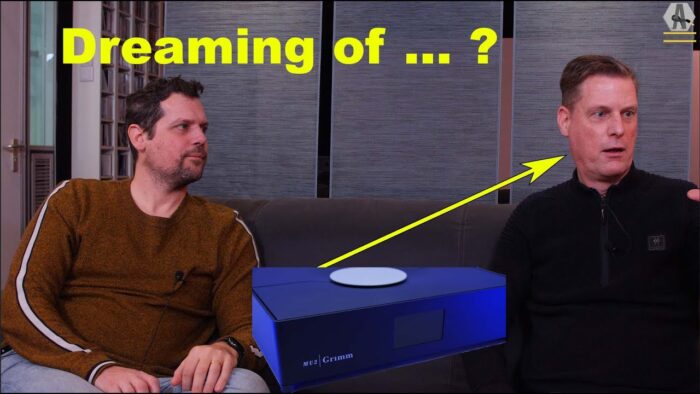來自荷蘭的Grimm Audio創立於2004年,核心成員全都是在電子、聲學、物理領域學有專精的專家。他們推出的 CC1v2外接時鐘有著優雅的實木裝飾面板,看似專為Hi End音響市場打造,但其實CC1v2在專業錄音領域一樣大受好評,全球許多著名錄音室都使用CC1v2 作為外接時鐘,性能優異可見一斑。
CC1v2配備1個word clock BNC輸入端子以及16個word clock BNC輸出端子,內建兩組獨立時鐘,分別產生 44.1kHz倍頻與48kHz倍頻時脈訊號,最高支援192kHz時脈訊號,時脈精度高0.6ps@10Hz。背板的BNC時脈輸出端子也分為兩組,當其中一組輸出44.1kHz時脈訊號時,另一組可以輸出44.1kHz的倍頻時脈訊號。能否一組輸出44.1kHz 倍頻,另一組輸出48kHz倍頻訊號呢? 不可能,因為同一套數位訊源同時只能使用同一種時脈訊號,不可能同時存在44,1kHz與48kHz兩種時脈頻率。 CC1v2除了可以作為整套數位訊源系統的主時鐘之外,最特別之處是可以當作Slave Clock使用。如何使用呢?CC1v2具備一個AES/EBU輸入與一 個AES/EBU輸出端子,使用時只要將 CC1v2接在數位轉盤之後,DAC之前, CC1v2便可以透過獨家PLL鎖相回路, 大幅降低前端訊源產生的時基誤差,在10Hz可以衰減90dB的時基誤差,10H到100Hz還可以進一步消除60dB的時基誤差。也就是說,數位音樂訊號在經過 CC1v2重整時脈訊號之後,輸出給DAC的將是完全沒有時基誤差的訊號! 為什麼CC1v2要提供Slave Clock模式呢?因為Grimm Audio認為在播放串流音樂時,每一首曲子的解析度可能都不相同,此時一般外接主時鐘會無法自動辨識源頭樂曲的取樣頻率,在使用上就會出現問題。此時如果採用Slave Clock 模式,以訊號源頭的串流播放器當作主時鐘,就不用擔心上述問題。
Grimm Audio還特別強調,一套數位訊源系統中只能有一個主時鐘,而這個主時鐘必須位在源頭。許多家用數位訊源中,只有DAC具備時脈輸入端子, 所以許多用家也就只在DAC加上外接時鐘,這種作法其實是不正確的。因為此時D A C與前端轉盤的時脈將無法同步一致,對於聲音表現未必會有正面的改善效果。Grimm Audio另有一款簡化版的CC2外接時鐘,只具備兩個BNC時脈輸出端子,如果你的數位訊源只有轉盤與DAC兩件式組合,那麼CC2已經足敷使用。
Grimm Audio from the Netherlands was founded in 2004, and its core members are all experts with expertise in the fields of electronics, acoustics and physics. The CC1v2 external clock they launched has an elegant solid wood decorative panel, which seems to be specially built for the Hi End audio market, but in fact CC1v2 is equally well-received in the professional recording field. Many famous recording studios around the world use CC1v2 as an external clock. The excellent performance can be seen Spotlight.
…….CC1v2 is equipped with 1 word clock BNC input terminal and 16 word clock BNC output terminals. It has two built-in independent clocks, which generate 44.1kHz and 48kHz multiplier clock signals respectively. It supports up to 192kHz clock signal with high clock accuracy. 0.6ps@10Hz. The BNC clock output terminals on the back panel are also divided into two groups. When one group outputs a 44.1kHz clock signal, the other group can output a 44.1kHz double-frequency clock signal….
…..CC1v2 can be used as the master clock of a complete set of digital source systems, and the most special feature is that it can be used as a slave clock. How to use it? CC1v2 has an AES/EBU input and an AES/EBU output terminal. When using it, just connect the CC1v2 after the digital turntable and before the DAC. The CC1v2 can use the exclusive PLL phase-locked loop to greatly reduce the front-end signal generation. The time base error can attenuate the time base error of 90dB at 10Hz, and the time base error of 60dB can be further eliminated from 10H to 100Hz. ………
……Grimm Audio also emphasized that there can be only one master clock in a digital source system, and this master clock must be at the source. In many home digital sources, only the DAC has a clock input terminal, so many users only add an external clock to the DAC. This practice is actually incorrect. Because the clocks of DAC and the front transport will not be synchronized at this time…..









NO COMMENT